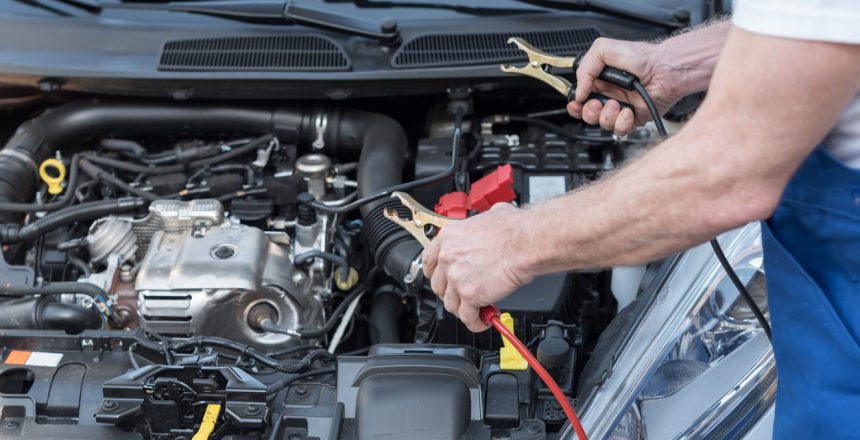If your car battery dies during transport or at any other time, knowing how to jump-start the vehicle can save you a headache.
Ending up with a dead car battery is a frustrating experience, especially if it occurs at an inopportune time. You need to go somewhere and attempt to turn the key, only to have nothing happen at all. The next step is often to call for some roadside assistance, but that takes time. When you’re in a hurry, or if you’ve just shipped your car to a new location and aren’t sure who to call, jump-starting the car yourself could be your only option.
Here’s an easy guide to how to jump-start your vehicle’s dead battery.
Key Takeaways
- Car batteries can die for many reasons
- Jump-starting a car is a straightforward process
- Learning how to jump the battery yourself is advisable for any driver
What causes dead car batteries?
Your car battery can die for many different reasons. You could have left the lights off, either interior or exterior, overnight. This problem commonly occurs with classic cars because their lights don’t turn off automatically and they may not have a warning bell to inform you of the issue.
Other issues that could potentially lead to your battery dying include:
- Extremely hot or cold temperatures
- Loose battery cables
- Taking an excessive number of very short drives that don’t give your alternator time to charge it.
- A short circuit in the car can slowly drain the battery
Fortunately, you can usually get your car up and running again by jump-starting the battery.
Getting set up
Before you can begin the repair, you’ll need to have the right equipment. All you really require is a good set of jumper cables, which you can get at any automotive retailer. These cables are inexpensive, and you can fold them up to store with your spare tire or under the seat.
Alternatively, you can buy a portable battery jumper and keep it in your car. These devices are convenient because they allow you to jump-start your car without a secondary vehicle to draw power from.
When using jumper cables, you’ll need another vehicle to provide the jump. Therefore, part of the process involves asking someone to help you out. You’ll want to park the two cars about 18 inches apart so the cables can reach between the vehicles and make sure both vehicles are turned off.
Attaching the cables
Once you have another car to help with the jump-starting process, you can attach the jumper cables to the cars. Begin by identifying the positive and negative sides of the battery. You don’t want to make a mistake here because you could damage both vehicles and injure someone.
Attach the red cable clamp to the positive side of the dead battery. The positive side will have a + marking, so you know where to attach it.
Next, attach the other red clamp to the positive side of the working car’s battery and then the black clamp to its negative side, marked by a – sign.
Finally, you’ll attach the remaining black clamp to a bolt on the engine block of the car with the dead battery away from the battery. Don’t connect it to the battery because that can create a dangerous spark when you start the vehicle.
Jumping the battery
Now that everything is connected, you’re ready to jump-start the car. Begin by starting the engine of the working vehicle and letting it run for a minute or two. This process allows the dead battery to take a charge and, hopefully, helps it to start.
If everything has gone smoothly, you can now start the car with the dead battery. In situations where it doesn’t start right up, let it charge for a couple more minutes and try again. The vehicle should eventually fire up.
Disconnecting the cables
Once the car is running, it’s time to disconnect the jumper cables. You’ll do this job in the opposite order that you attached them. Start with the black cable on the engine block. Next comes the black clamp on the working vehicle, then the red clamp on the functional vehicle’s battery, and, finally, the other red clamp.
Make sure you take your car for a drive after disconnecting the cables to give the alternator a chance to charge it completely. That way, you don’t have to worry about the vehicle not starting again the next time you need it.
Shipping a vehicle
If you’re looking to ship a vehicle to another part of the country, make sure you have your lights off and disconnect any devices from the inside of the car (like a radar detector) before putting it on the truck. Taking the car to a mechanic for the necessary maintenance before shipping can also help ensure it starts up upon arrival.
If you still end up experiencing battery trouble when your vehicle reaches its destination, it’s nice to know how simple it is to jump-start without requiring roadside assistance.
Shipping your vehicle doesn’t have to be a stressful experience. Learning how to jump the battery means you can handle the situation if the car doesn’t start. Using a quality broker like Mercury Auto Transport can also eliminate stress by ensuring you end up with a reputable carrier.
Contact us today to request a quote or to talk to a car shipping representative.






